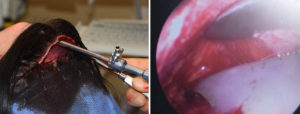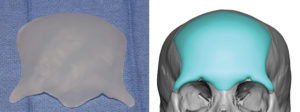Background: The best method to aesthetically augment the entire forehead is with a custom implant approach. Being able to select the exact dimensions and shape of the implant beforehand and design it on the patient’s 3D CT scan offers a huge aesthetic advantage over creating the augmentation by hand intraoperatively with bone cements. While there is no exact method of designing a custom forehead implant knowing the exact dimnessons to create the look the patient wants, at the least the implant will be perfectly smooth and have a good fit to the underlying frontal and brow bones.
Another significant aesthetic advantage to a custom forehead implant is that the scalp incision needed to place it can be much smaller. A typical full coronal or even hemi-coronal scalp incision is not necessary. With a performed implant wide open visibility is not needed as the implant has the desired preformed shape. What is needed is just enough of an incision to get the implant through it and positioned into the desired anatomic location.
Through this small scalp incision the subperiosteal implant pocket must be dissected out with care taken along the entire supraorbital rim. Not only must the supraorbital nerve be protected but gentle dissection is needed along the brow bones over the eye to lessen the amount of periorbital swelling and bruising that can occur.
For an adequate implant pocket and controlled dissection that does not disrupt or injure periorbital structures, this is where the use of the endoscope has tremendous value. Through a smaller incision at a distant location (scalp) the endoscope is inserted where the periosteal release along the lower edge of the brow bones and around the supraorbital nerve can be effectively and safely done.
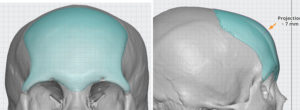
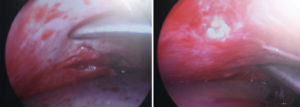
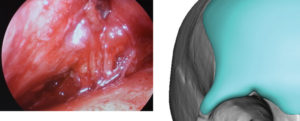
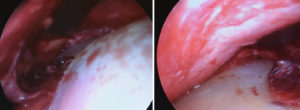
correct position. Re-insertion of the endoscope is used to check this positioning, particularly the tails the implant down towards the frontozygomatic sutures.

The endoscopic-assisted custom forehead implant placement technique is of great value when the forehead implant design includes the brow bones and needs to be placed down over them. It provides visual confirmation of the extent of the dissection as well as positioning of the inferior implant edges.
Highlights:
1) Many custom forehead implants include coverage of the brow bones which is where it is hardest to ensure optimal positioning.
2) One of the benefits of custom forehead implant is the need for far less scar burden to insert it.
3) The endoscope provides the necessary visualization to safely direct along the brow bones where the small scalp incision does not provide good visibility.
Dr. Barry Eppley
Indianapolis, Indiana



